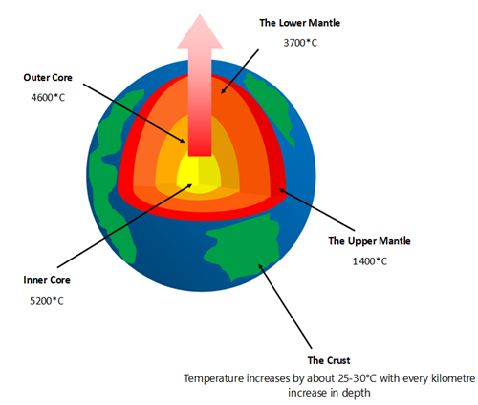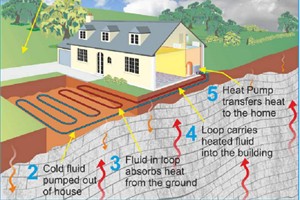What is Geothermal Energy?
|
|
|
|
|
Geothermal energy is defined as energy in the form of heat stored beneath the surface of the Earth. This heat comes from deep inside the Earth. The temperature of the Earth increases with depth.
|
The Earth is composed of three main layers: the crust, the mantle, and the core. Heat constantly flows from the core to the surface. Temperatures are at their hottest at the centre of the Earth, which is around 5,000 ˚C, and decrease towards the ground surface. This is called the geothermal gradient. Most of the heat inside the Earth is created by the natural decay of radioactive elements in different rock types. Some heat is also left over from when the planet formed about 4.5 billion years ago, called primordial heat. Close to the Earth's surface – in the top few 10s to 100s of metres – most of the heat stored in the ground comes from the Sun (solar irradiation).
|

| 
|
Where is Geothermal Energy Stored?The diagram on the right shows a geothermal reservoir, similar to one we may have in Ireland. The Geothermal Source provides heat to a water-bearing Reservoir which can be used to access the geothermal resource. The Insulator layer traps the heat in the Reservoir.
|
|

|
What can be Geothermal Energy be used for?
|
|
Geothermal energy can be used in a wide range of applications including space heating (and cooling), industry, agriculture and even for electricity generation. Temperatures as low as 10˚C can be used for heating, while temperatures of 150˚C or more would be required for electricity generation. In volcanic areas such as Iceland, geothermal energy can be a major source of energy but geothermal energy resources can also be found in areas where there is no volcanic activity, far from tectonic plate boundaries. Geothermal energy is used for heating and cooling purposes in countries such as France, Denmark, Belgium, Netherlands and Ireland.
Geothermal energy resources are often divided into two categories; shallow and deep. Different methods are used to extract the energy, and it can have different uses.
|
Why choose geothermal energy?Geothermal energy is a secure, environmentally sustainable, and cost-effective source of renewable energy. Approximately one-third of our energy demand is in the heating sector, the vast majority of which is powered by fossil fuels. Geothermal energy is a renewable, low-to-zero carbon emission resource. By tapping into our national geothermal energy resources, we could replace
some of these fossil fuels with a secure and sustainable heating alternative.
|

|
How can Geothermal Energy be used?
| | |
Geothermal energy resources are often divided into two categories, shallow and deep. Different methods are used to extract the energy, and it can have different uses. A variety of technologies can be used to extract heat from the subsurface.
|
| Shallow Geothermal Energy Heat is harnessed from the shallow subsurface usually from depths of between 0-200 m and occasionally up to 500 m. There are two main types of collector system (or loops) used to extract heat from the ground (or to release heat into the ground for cooling purposes), and these are known as 'open loop' or 'closed loop' collectors. Closed loop systems have a closed pipe known as a loop buried in the ground which is filled with a fluid, known as a 'thermal transfer fluid'. As this fluid circulates around the loop, it absorbs heat, which is then passed over a heat exchanger. An open loop collector obtains energy directly from the water by pumping it through a heat exchanger. | 
|
These open or closed loop collectors are installed around a home or commercial building in either a 'vertical' or 'horizontal' arrangement. Horizontal collectors are typically buried in shallow trenches, stripped ground or placed in ponds or rivers, while vertical collectors are installed in drilled boreholes or wells. The heat energy that is taken from the shallow ground is low temperature, which has to be boosted using a heat pump before being used in a heating system. These systems can also be used in reverse, and waste heat can be injected into the ground, to cool a building.
|
Deep Geothermal Energy Using deep geothermal energy involves drilling much further below the ground surface than for shallow systems in order to harness higher temperatures deeper underground. The temperatures reached at great depths can be used to generate electricity or, more commonly, to supply district heating networks or buildings.
For deeper geothermal systems, technologies such as EGS and AGS are utilised. EGS (Enhanced Geothermal Systems) , involves improving the permeability of the rocks to create an artificial reservoir in geothermal settings where the subsurface temperatures are high but permeability is low. AGS (Advanced Geothermal Systems) are deep, large circuits, with one or more wells drilled into hot rock with fluid circulating through a closed-loop system to bring heat to the surface. Additionally with higher temperatures, there is potential for geothermal electricity production. The most common geothermal electricity generation uses steam power plants. Fluids at very high temperatures are pumped up from deep underground and produce steam. The steam then drives a turbine, which in turn generates electricity.
|

|
| | |
Geothermal Energy in Ireland Ireland has excellent shallow geothermal energy reserves all over the country. Our shallow groundwater provides a stable resource of thermal energy that can be used to provide heating at very high efficiencies. Ground Source Heat Pumps (GSHPs) are becoming more and more popular and with sufficient insulation, these can be a very efficient method of heating our homes and businesses. To learn more about installing a ground source heat pump in your home see our home owners manual.
Ireland also has recognised potential for deep low-to-medium temperature geothermal energy resources. These may be suitable for large-scale or district heating and cooling in municipal, residential and industrial areas. The GSI published An Assessment of Geothermal Energy for District Heating in Ireland.
| |
In 2020, the Department of the Environment, Climate and Communications published a key document in the development of geothermal in Ireland, "A roadmap for a policy and regulatory framework."
In 2023, the Minister for the Environment, Climate and Communications, Eamon Ryan TD, published the "Policy Statement on Geothermal Energy for a Circular Economy."
|
|